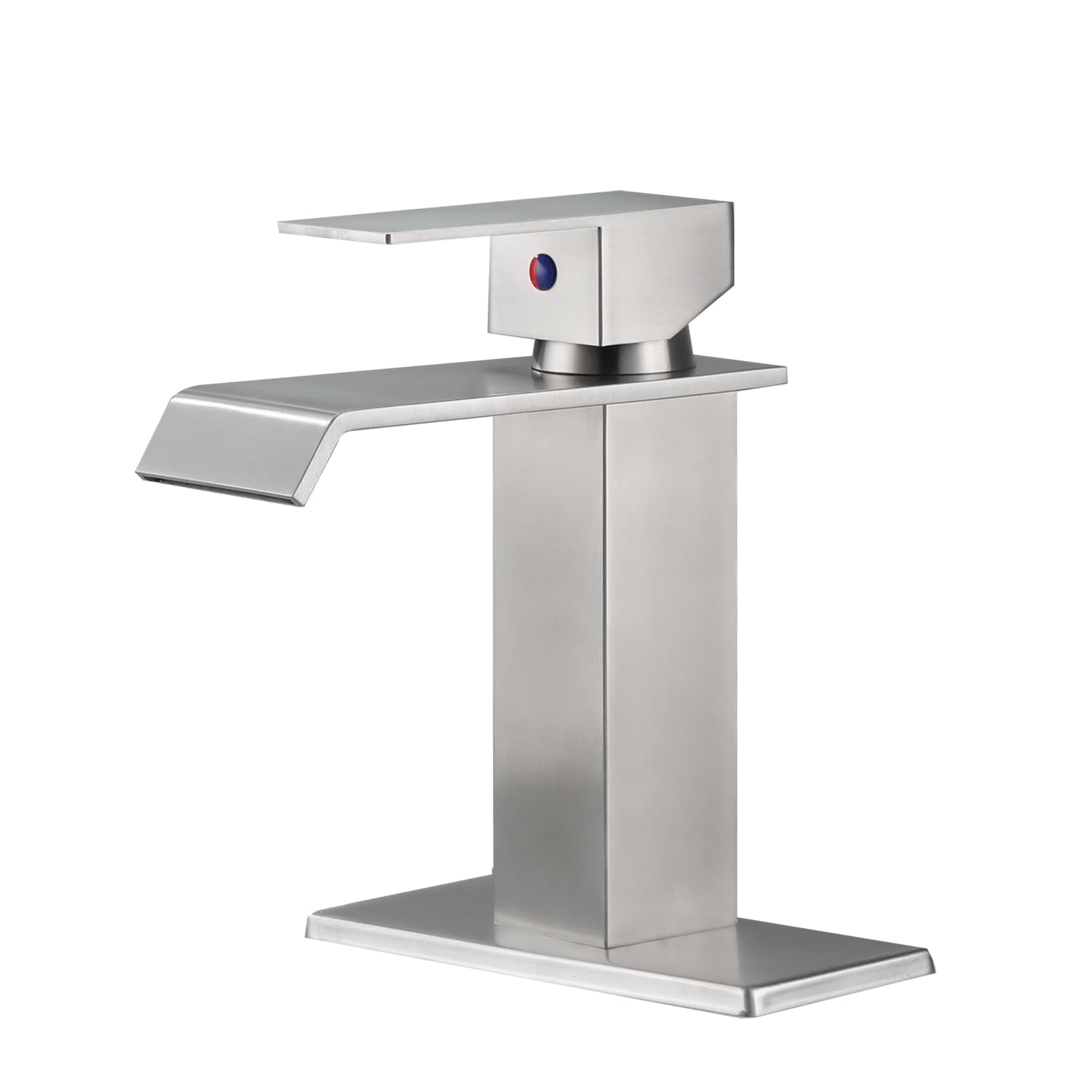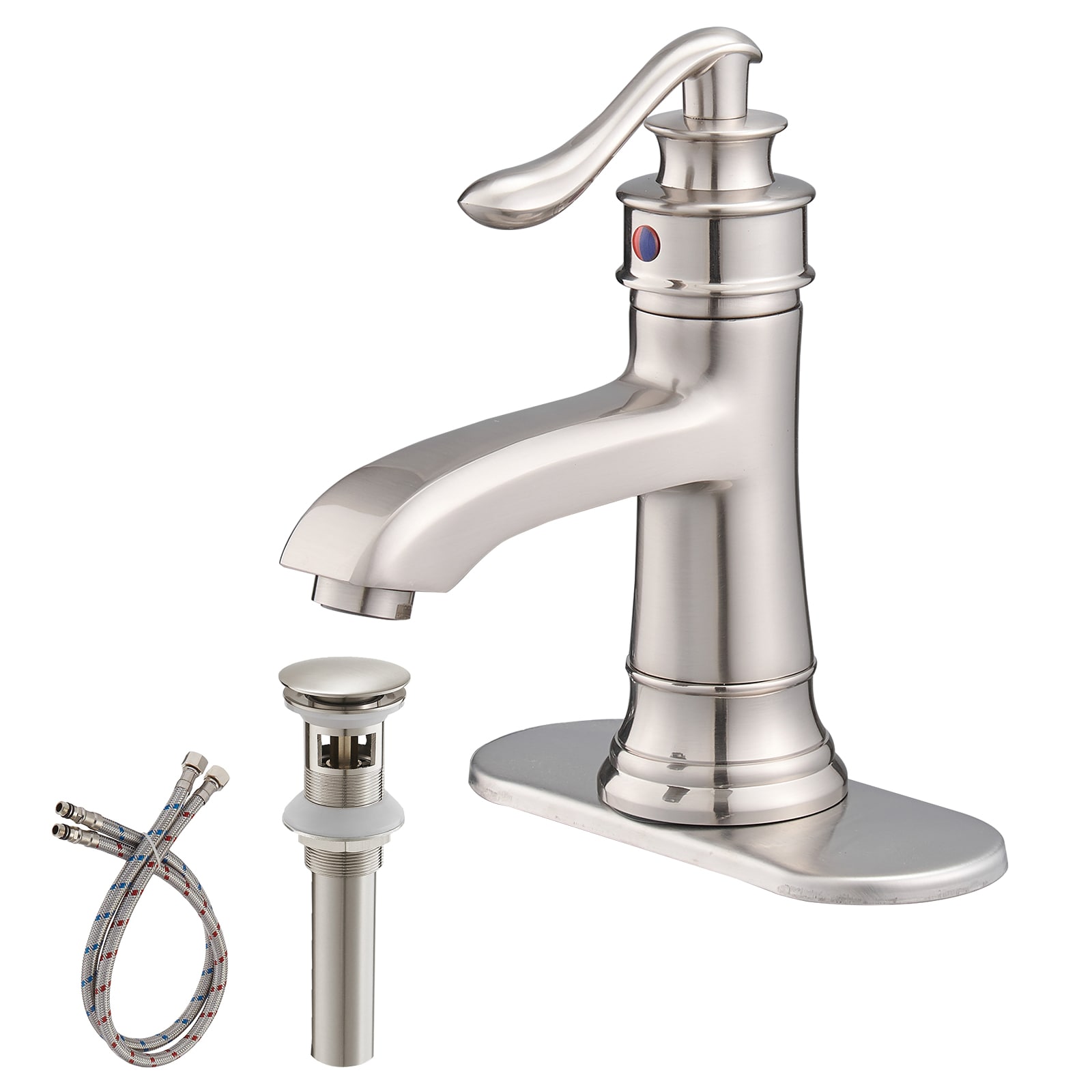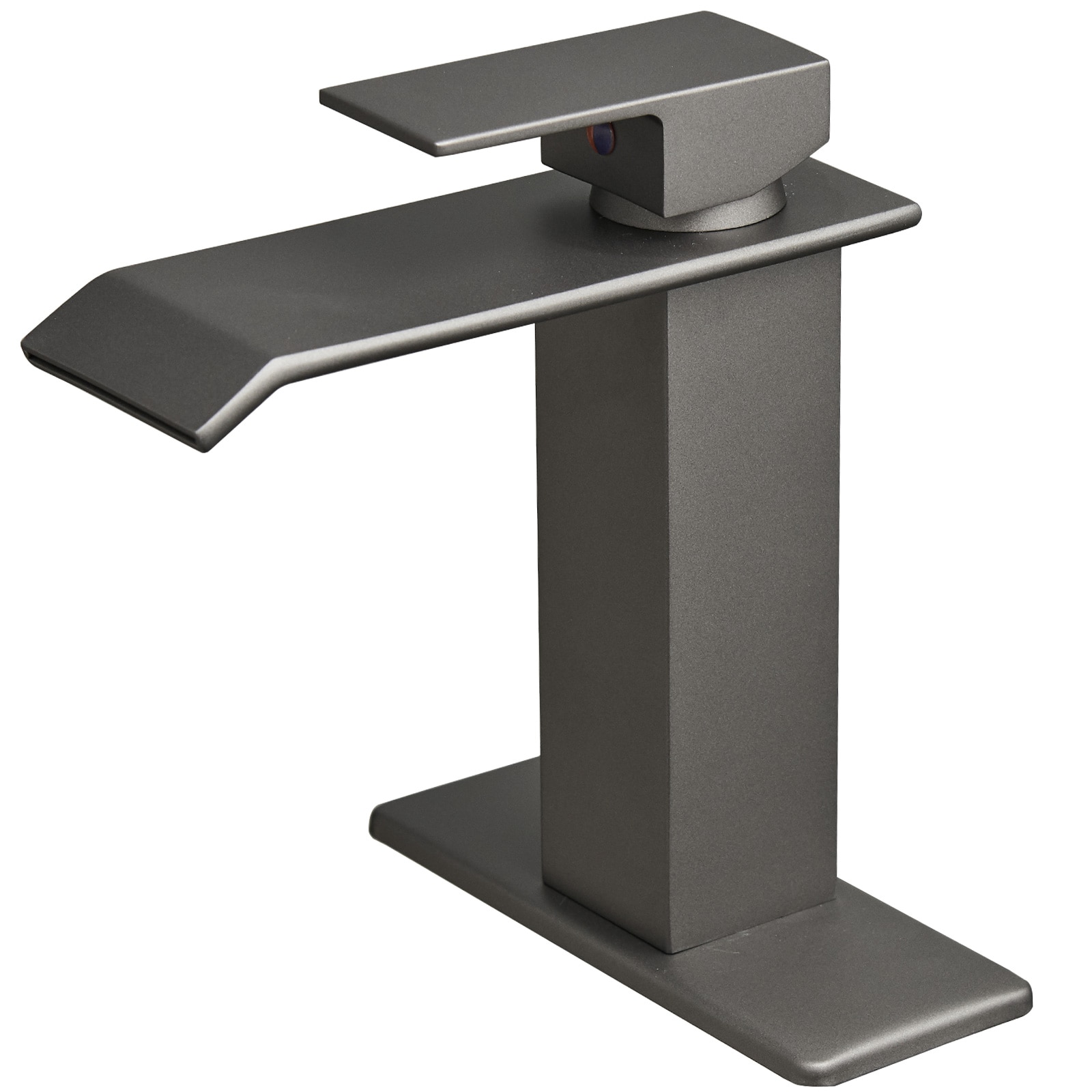Single Hole Bathroom Faucet Features
Single-hole bathroom faucets are a popular choice for modern bathroom designs. They offer a sleek and minimalist look, while also providing excellent functionality. These faucets are characterized by their single mounting hole, which simplifies installation and makes them ideal for smaller bathroom sinks.
Advantages of Single Hole Design, Single hole bathroom faucet lowes
The single-hole design offers several advantages for bathroom sinks:
- Space-saving: Single-hole faucets require less space on the countertop compared to widespread or centerset faucets, making them ideal for smaller bathroom sinks.
- Simplified Installation: Installing a single-hole faucet is typically easier and faster than installing faucets with multiple holes. This reduces the overall installation time and cost.
- Clean and Modern Aesthetic: The streamlined design of single-hole faucets creates a sleek and modern look that complements various bathroom styles.
Finishes for Single Hole Bathroom Faucets
Single-hole bathroom faucets are available in a wide range of finishes to match different bathroom styles and preferences. Some popular finishes include:
- Chrome: A classic and durable finish that provides a bright and reflective surface.
- Nickel: A slightly warmer and more subdued finish than chrome, often with a brushed or satin finish.
- Brushed Nickel: A popular choice for its contemporary look and resistance to fingerprints.
- Oil-Rubbed Bronze: A rich and warm finish that creates a vintage or rustic look.
- Matte Black: A sophisticated and modern finish that adds a touch of elegance to the bathroom.
Spout Styles for Single Hole Bathroom Faucets
The spout style of a single-hole bathroom faucet is an important consideration, as it affects the functionality and aesthetics of the sink. Different spout styles are suited for different sink types:
- High-Arc Spout: A tall, curved spout that provides ample clearance for filling tall containers or cleaning large sinks. These spouts are ideal for vessel sinks or sinks with deep basins.
- Mid-Arc Spout: A shorter, curved spout that offers a balance between clearance and functionality. Mid-arc spouts are suitable for a variety of sink types, including undermount sinks and countertop sinks.
- Low-Arc Spout: A short, straight spout that is typically found on smaller faucets. Low-arc spouts are ideal for smaller sinks or sinks with limited counter space.
Single Hole Bathroom Faucet Installation: Single Hole Bathroom Faucet Lowes
Installing a single hole bathroom faucet is a DIY project that can save you money and give you a sense of accomplishment. However, it’s crucial to follow the right steps and use the appropriate tools and materials to ensure a successful and watertight installation.
Tools and Materials
A successful installation requires the right tools and materials. Here is a list of essential items you will need:
- Adjustable wrench
- Channel-lock pliers
- Phillips screwdriver
- Plumber’s tape
- New single-hole bathroom faucet
- New supply lines (if needed)
- New escutcheon plate (if needed)
- New mounting ring (if needed)
- Silicone sealant
- Safety glasses
- Gloves
Step-by-Step Installation Guide
Here is a detailed step-by-step guide for installing a single-hole bathroom faucet:
- Turn off the water supply: Before you begin, turn off the water supply to the bathroom. This is usually done by turning the shut-off valves located beneath the sink. Once the water is off, open the faucet to drain any remaining water.
- Remove the old faucet: Unscrew the old faucet from the sink using an adjustable wrench. If the old faucet is stuck, you can use channel-lock pliers to loosen it. Once the faucet is removed, remove the old supply lines and escutcheon plate.
- Clean the sink opening: Use a cleaning cloth to remove any dirt or debris from the sink opening. This will ensure a clean and secure connection for the new faucet.
- Install the mounting ring: If your new faucet comes with a mounting ring, install it on the sink opening. This ring will help to secure the faucet and prevent it from loosening over time.
- Attach the supply lines: Connect the new supply lines to the faucet. Use plumber’s tape to wrap the threads of the supply lines to prevent leaks. Hand-tighten the connections, and then use an adjustable wrench to tighten them securely.
- Install the faucet: Place the faucet on the sink opening and align it with the holes in the sink. If the faucet has an escutcheon plate, install it around the base of the faucet. Tighten the mounting nut underneath the sink to secure the faucet in place.
- Connect the supply lines to the water source: Attach the other ends of the supply lines to the shut-off valves under the sink. Use plumber’s tape on the threads of the valves and tighten the connections securely.
- Turn on the water supply: Slowly turn on the water supply to the bathroom. Check for any leaks around the faucet and supply lines. If you find any leaks, tighten the connections or re-apply plumber’s tape as needed.
- Test the faucet: Turn on the faucet and test the hot and cold water flow. Ensure the faucet operates smoothly and that there are no leaks. If you notice any problems, check your connections and tighten them if necessary.
Faucet Alignment and Watertight Connections
Proper alignment and watertight connections are essential for a successful installation. Here are some tips:
- Alignment: Before you tighten the mounting nut, ensure the faucet is perfectly aligned with the sink opening. This will prevent the faucet from being crooked or tilted. You can use a level to ensure proper alignment.
- Watertight connections: Use plumber’s tape on all threaded connections to prevent leaks. Wrap the tape tightly around the threads in the direction of the flow of water. Do not overtighten the connections, as this can damage the threads or the faucet itself.
- Silicone sealant: Apply a bead of silicone sealant around the base of the faucet to prevent water from leaking behind the faucet. This is especially important if the faucet has an escutcheon plate.
Importance of Using Appropriate Tools and Materials
Using the right tools and materials is essential for a successful installation. Here are some reasons why:
- Proper fit: The correct tools will ensure that you can tighten the connections securely without damaging the faucet or the supply lines.
- Leak prevention: Plumber’s tape and silicone sealant are essential for preventing leaks. Using the wrong type of tape or sealant can lead to leaks and damage.
- Safety: Using the right tools and materials will help to ensure a safe installation. This includes using safety glasses and gloves to protect yourself from injuries.
Connecting the Faucet to the Water Supply Lines
Connecting the faucet to the water supply lines is a crucial step in the installation process. Here are some key points to remember:
- Use the correct supply lines: The supply lines should be compatible with the faucet and the shut-off valves under the sink.
- Tighten the connections securely: Hand-tighten the connections, and then use an adjustable wrench to tighten them securely. Do not overtighten the connections, as this can damage the threads or the faucet itself.
- Check for leaks: After connecting the supply lines, turn on the water supply and check for leaks. If you find any leaks, tighten the connections or re-apply plumber’s tape as needed.
Single Hole Bathroom Faucet Types

Single hole bathroom faucets are a popular choice for modern bathrooms due to their sleek design and ease of installation. They offer a wide range of styles and functionalities to suit different bathroom aesthetics and preferences. This section will explore the different types of single hole bathroom faucets based on their functionality and design styles.
Functionality
Single hole bathroom faucets are typically categorized based on their functionality, which can be broadly divided into single-handle, two-handle, and touchless faucets.
- Single-handle faucets offer a single lever for controlling both hot and cold water flow and temperature. They are easy to use and provide precise control over water temperature.
- Two-handle faucets feature separate handles for controlling hot and cold water flow. They offer a more traditional look and are often preferred for their separate control over water temperature.
- Touchless faucets are activated by motion sensors, providing a hands-free and hygienic experience. They are particularly useful in bathrooms with high traffic, such as guest bathrooms or public restrooms.
Design Styles
Single hole bathroom faucets come in various design styles to complement different bathroom aesthetics.
- Traditional faucets typically feature ornate designs with curves and embellishments. They often have cross handles or lever handles with decorative accents.
- Modern faucets are characterized by clean lines, minimalist designs, and sleek finishes. They often feature geometric shapes and angular lines.
- Contemporary faucets blend modern elements with a touch of traditional elegance. They often feature geometric shapes with subtle curves and intricate details.
Single-Handle Faucets
Single-handle faucets offer a simple and efficient way to control water flow and temperature. They are known for their ease of use and precise control. Single-handle faucets are available in various styles, from minimalist modern designs to traditional cross handles.
- Pros:
- Easy to use and control water temperature.
- Sleek and modern design.
- Wide range of styles available.
- Cons:
- Can be more expensive than two-handle faucets.
- May not be suitable for all bathroom aesthetics.
Two-Handle Faucets
Two-handle faucets offer separate control over hot and cold water flow, allowing for more precise temperature adjustments. They are often preferred for their traditional look and feel. Two-handle faucets are available in a variety of styles, from classic cross handles to lever handles with decorative accents.
- Pros:
- Offer separate control over hot and cold water flow.
- Traditional and elegant design.
- More affordable than single-handle faucets.
- Cons:
- May not be as easy to use as single-handle faucets.
- Can be less space-efficient than single-handle faucets.
Touchless Faucets
Touchless faucets are activated by motion sensors, providing a hands-free and hygienic experience. They are ideal for bathrooms with high traffic, such as guest bathrooms or public restrooms. Touchless faucets are available in various styles, from minimalist modern designs to sleek contemporary styles.
- Pros:
- Hands-free operation for hygiene and convenience.
- Reduce the spread of germs and bacteria.
- Energy-efficient due to automatic shut-off.
- Cons:
- Can be more expensive than traditional faucets.
- May require specialized installation.
Single Hole Bathroom Faucet Brands at Lowe’s

Lowe’s offers a wide range of single hole bathroom faucets from reputable brands, each with its own unique features and benefits. Choosing the right brand depends on your budget, desired style, and specific requirements. This section will delve into some of the top brands available at Lowe’s, highlighting their key features, price ranges, warranties, and customer reviews.
Top Single Hole Bathroom Faucet Brands at Lowe’s
Here’s a table showcasing the top single hole bathroom faucet brands at Lowe’s, along with their key features, price ranges, warranties, and customer reviews:
| Brand | Key Features | Price Range | Warranty | Customer Reviews |
|—|—|—|—|—|
| Delta | Known for its innovative features like Touch2O technology, Diamond Seal Technology, and a lifetime limited warranty. Offers a wide variety of styles, from modern to traditional. | $100 – $500+ | Lifetime Limited | Generally positive, with high ratings for durability and reliability. |
| Kohler | Offers a wide selection of single hole bathroom faucets in various styles, including contemporary, transitional, and traditional. Known for its quality craftsmanship and long-lasting finishes. | $100 – $500+ | Lifetime Limited | Highly rated for quality, design, and durability. |
| Moen | A leading brand in the plumbing industry, Moen offers a wide range of single hole bathroom faucets with various finishes and styles. Known for its innovative features like the M-PACT common valve system. | $100 – $500+ | Lifetime Limited | Generally positive, with high ratings for reliability and ease of installation. |
| Grohe | A German-based brand known for its high-quality, stylish faucets. Offers a wide selection of single hole bathroom faucets in various styles and finishes. | $200 – $1000+ | Lifetime Limited | Highly rated for quality, design, and performance. |
| Pfister | Offers a wide range of single hole bathroom faucets in various styles and finishes, with a focus on affordability. Known for its reliable performance and durable finishes. | $50 – $200 | Lifetime Limited | Generally positive, with high ratings for value for money and ease of installation. |
Single Hole Bathroom Faucet Maintenance

Regular maintenance is essential to ensure your single-hole bathroom faucet functions smoothly and lasts for years. A well-maintained faucet prevents leaks, drips, and mineral buildup, preserving its aesthetic appeal and preventing costly repairs.
Routine Maintenance Schedule
A routine maintenance schedule helps keep your faucet in top condition. Here’s a recommended schedule:
- Monthly: Wipe down the faucet with a soft, damp cloth to remove dust and fingerprints. Pay attention to the handle, spout, and base.
- Quarterly: Clean the aerator to remove mineral buildup and ensure optimal water flow. Use a small brush or toothpick to remove any debris.
- Annually: Inspect the faucet for any signs of wear and tear, such as loose handles, dripping, or leaking. Tighten any loose components and lubricate moving parts with silicone spray.
Cleaning and Descaling
Mineral buildup can restrict water flow and damage the faucet’s finish. To prevent this, follow these steps:
- Use a mild cleaning solution: Mix equal parts white vinegar and water in a spray bottle. Apply the solution to the faucet, focusing on areas with mineral buildup. Allow it to sit for 15 minutes, then scrub with a soft-bristled brush. Rinse thoroughly with water.
- Avoid abrasive cleaners: Harsh chemicals and abrasive cleaners can damage the faucet’s finish. Use a soft cloth and mild cleaning solutions.
- Regularly clean the aerator: The aerator, located at the spout’s end, mixes air with water to create a smooth flow. Regularly remove and clean the aerator to prevent mineral buildup.
Troubleshooting Common Issues
- Leaks and drips: A leaky faucet can waste water and cause damage. If you notice a leak, inspect the faucet for loose or worn-out parts. Tighten any loose components and replace any worn-out parts.
- Low water pressure: Mineral buildup in the aerator can cause low water pressure. Clean the aerator to improve water flow.
- Sticking handles: A sticking handle indicates a worn-out cartridge or a buildup of debris. Clean the cartridge or replace it if necessary.
Replacing Worn-Out Parts
- Cartridge: The cartridge controls water flow and temperature. Replace it if it’s worn out or damaged.
- Aerator: The aerator mixes air with water to create a smooth flow. Replace it if it’s damaged or clogged with mineral buildup.
- O-rings: O-rings are small rubber rings that prevent leaks. Replace them if they are cracked or worn out.
